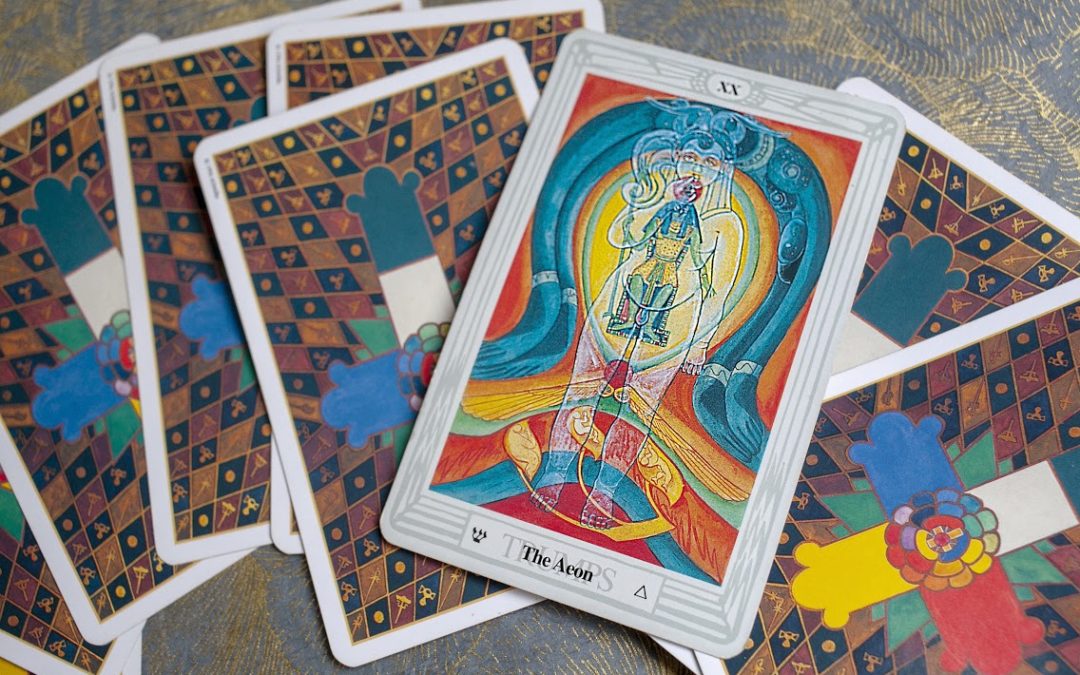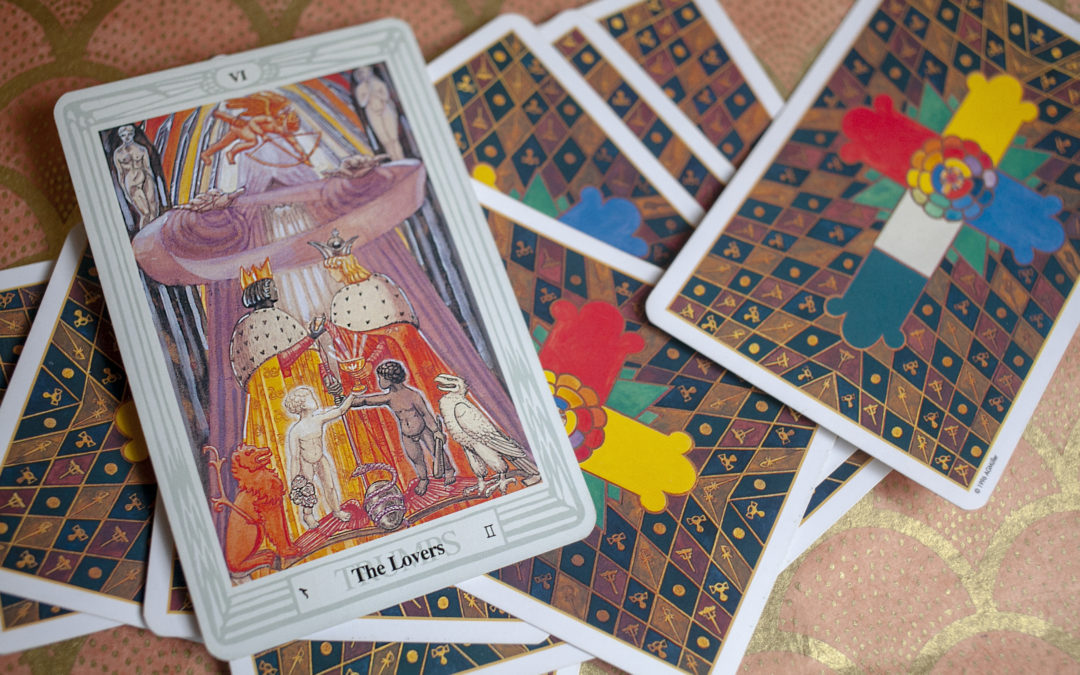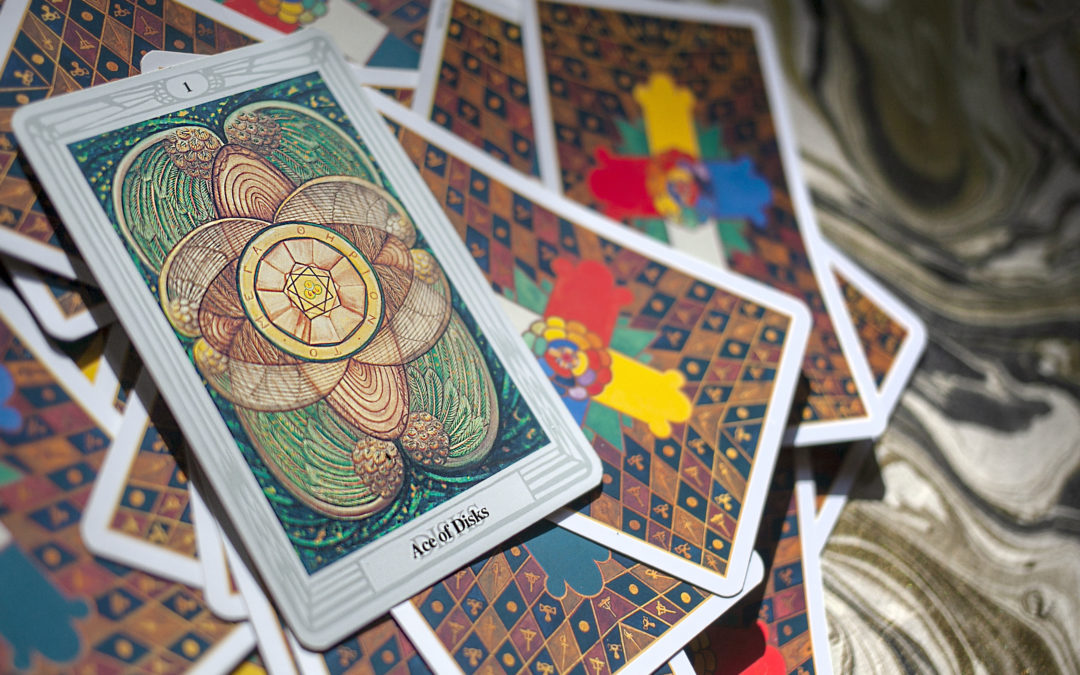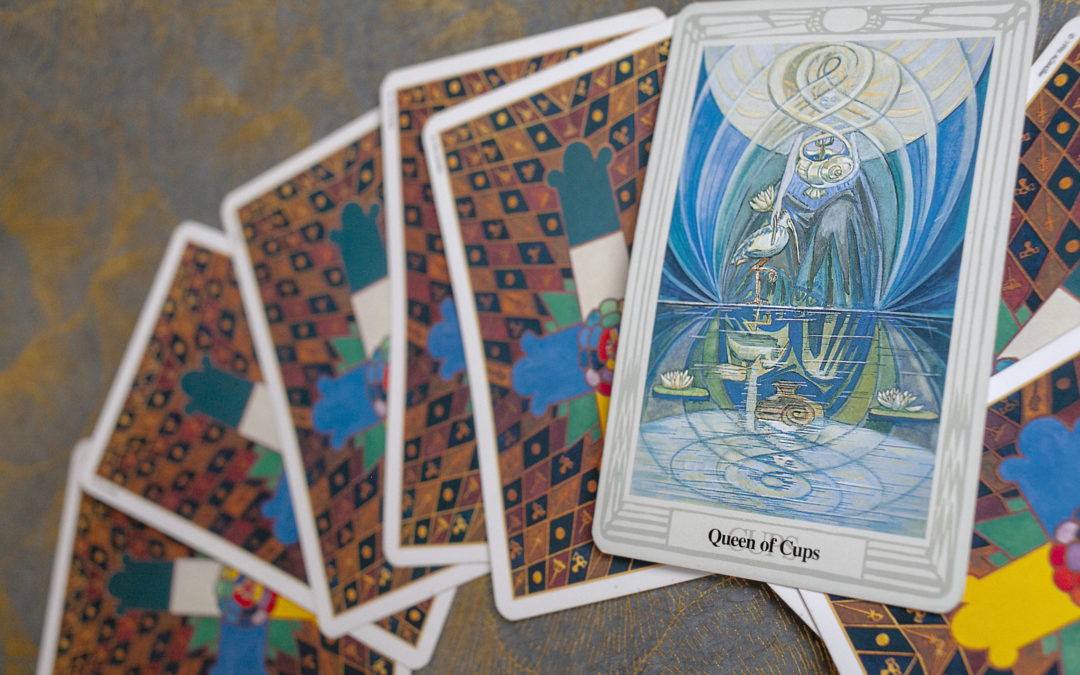
by Kosmic Tonic | Mar 4, 2019 | Tarot
This has been one of the hardest Thoth cards for me to tap into: partly because I’ve read so many conflicting interpretations. Angeles Arrien describes the central gods as Osiris, in child and adult forms. Except the falcon-headed god at the centre is unambiguously Horus, Osiris’ son. Even the gauzy child overlay resembles Horus the Child, who was depicted in statues as a naked boy with a finger pressed to his mouth. Interestingly, this hand position features in the Egyptian hieroglyph for “child.” It’s possible this symbol was actually misinterpreted by Greek and Roman poets to mean “silence.” And so Harpocrates, the Greek God adopted from Horus, became the God of secrecy.
To me, he still resembles a boy licking honey (or jam, or ice cream) off his finger.
I think, too, of the word “horizon.” How it seems to contain the words “Horus rising,” or even “Horus sun,” even if the etymological link is invented: symbolically pleasing, but ungrounded in history. It is true that Horus became the Egyptian Sky God, and that in child forum, he represented the newborn sun warming the dawn horizon.
Back-bending over child and adult Horus, is Nut (or Nuit or Nuith), the goddess of the night sky. Angeles Arrien describes her shape as the glyph for Leo. Angel Paths connects her form to the ankh symbol. Esoteric meanings calls it the omega. The latter seems most likely to me. The Aeon card correlates to “Judgment” in other decks, and the Omega echoes that Biblical imprint: “I am the Alpha and the Omega, the first and the last, the beginning and the end.”
And I suppose that’s where the interpretation really begins for this card: both its iteration in more traditional decks as “Judgment,” and here as the Aeon, or an immeasurable period of time. The card orbits the threshold between midnight and dawn; child and adult; life and pre-life, indicated by the fetal figures nestled in the Hebrew letter ש (pronounced “shin” or “shein.”)
Crowley’s religion, Thelema, identified three aeons: the Aeon of Isis, the Aeon of Osiris, and now, the Aeon of Horus, defined by self-realization and self-actualization. It aligns closely with our conception of the Age of Aquarius: a sort of idealizing of our present potential and the future we’re tipping into.
In Little Essays Toward Truth, Crowley writes: The Aeon of Horus is here: and its first flower may well be this: that, freed of the obsession of the doom of the Ego in Death, and of the limitation of the Mind by Reason, the best men again set out with eager eyes upon the Path of the Wise, the mountain track of the goat, and then the untrodden Ridge, that leads to the ice-gleaming pinnacles of Mastery.
So what does this all add up to?
Time. Self-evaluation and evolution. Potential.
A theme of triplicity dominates this card. There’s no obvious link to any of the signs or planets of the zodiac, but a trine symbol (△) at the bottom right, opposite the Hebrew ש (“shin.”) According to Rabbi Aaron L. Raskin, the three vertical lines of ש represent the three dimensions of a human being: kesser (will and pleasure), the intellect and emotions.
Shin has fine definitions in Hebrew. The one Crowley focuses on is “tooth.” I first interpreted this in a threatening way… the “tooth” of judgment like the “fist” of Saturn, or some other punishing body part. But there’s also the connotation of chewing your food before you eat it: chewing over an idea before you act.
When you combine all of these symbols together: Horus, the three aeons, Night in wheel pose, the fetal figures painted in the golden rod ש, alongside the traditional interpretation of this card as Judgment, the key message seems to be: only you are responsible for your own thoughts, action and evolution. The author at Angel Paths phrases it well when she says: The Aeon forces us to acknowledge that our actions set up a chain of cause-and-effect for which we are solely responsible. Here we pass through the fire of purification, shedding dead and dying wood as we go. We judge ourselves frankly, forgive, and leave the past behind.
There is a theme of archways. Of passing through. Not passively awaiting our day of judgment, but turning an eye onto our own patterns, our own participation in games.
As Camus writes in The Fall: I shall tell you a great secret, my friend. Do not wait for the Last Judgment. It takes place every day.
When this card comes up in readings, it may indicate a turning point. A moment where you pass into a new phase (or aeon.) All of your decisions and actions until now have led to this moment. You are your own gatekeeper. Trust yourself.
References:
Camus, Albert. The Fall.
Crowley, Aleister. The Book of Thoth.
Crowley, Aleister. Heart of the Master.
Raskin, Aaron. “Shin—The Matriarchs.”
Angel Paths
Esoteric Meanings

by Kosmic Tonic | Feb 28, 2019 | Tarot
My lasting sensory impression of this card is velvet—or another sumptuous textile, maybe polar bear fur. The Lovers is the 6th card of the major arcana and the first featuring more than one figure. The imagery is so Venusian, I might have assumed the correspondent sign would be Libra or Taurus…but it’s Gemini.
On first glance, this card couldn’t appear less like the Twins. It feels opulent. Heavy. Weighted like bodies or feelings. When I think of Gemini, I imagine more aerial beings, like bees whisking between stalks of lavender, spreading their pollen. (There is actually bee imagery on this card, if you look closely: on the Empress’ robe. By contrast, the Emperor wears snakes.)
But the entire card is a mirror. At this point it is worth acknowledging that the card itself is a twin to the Art card (equivalent of Temperance in other decks.) Both cards feature twin imagery, and they mirror each other. In The Lovers, we see a red lion and white eagle. In Art, these colours are reversed. Two naked babes stand at the centre: one carries a bouquet of flowers and a chalice. The other, a hammer and a lance. According to Crowley, they represent Cain and Abel. Above them, we see the Emperor and Empress, and above the Emperor and Empress: a violet wizard (the Hermit), his face shrouded by the magic that whips about his hands. At the top, we find two nude figures: Lilith and Eve. Cupid arcs over the Hermit with his bow—and even this shape is reflected in the hidden bow at the bottom of the card, which nestles an Orphic Egg. It’s one of the most complicated cards in the deck.
In his Book of Thoth, Crowley writes: “Each of these symbols is in itself double, so that the meanings form a divergent series, and the integration of the Card can only be regained by repeated marriages, identifications, and some form of Hermaphroditism.”
I like this sentence as it applies to Gemini minds: themselves double, forever spinning a divergent series of thoughts, finding integration by way of repeated symbolic marriages, identifications, “and some form of Hermaphroditism.” (Side note: Hermaphroditos was the son of Hermes and Aphrodite. As the name implies, they possessed traits of both sexes.)
It makes me think of how light shines off the surface of the ocean: catching many faces in the surface of the wave. Does that make the light, or the wave, inconstant? Only if you’re fixating too narrowly on fluid shards of water. Only if you’re trying to fix a moving thing.
Gemini’s air element may be represented by the sacred lance in the centre of the card. There are also swords in the background, curved and projecting a form of cage. This imagery is important because sharp items sever. How do you reach two? By splitting the one in half.
Chani Nicholas writes that no one looks harder for their counterpart than Gemini. As if they yearn toward a mirror image they can’t fully embody on their own: not without shifting, not without tasting everything. Not without reaching and bending and veering toward their imagined twin.
Angeles Arrien’s interpretation of The Lovers card begins with a quote from Anais Nin: “The value of personal relationship to all things is that it creates intimacy and intimacy creates understanding and understanding creates love.” And love is not singular. What we use one word for in English, other languages find plural; Arabic includes eleven words for love; Sanskrit has 96 (!). Ancient Greek differentiates between eros (passionate love), philia (friendship), storge (parents and children), agape (universal love), ludus (playful, 5th house love), pragma (enduring love), and philautia (self love), among others. All shifting faces in the body of a wider ocean.
References:
Book of Thoth by Aleister Crowley
The Tarot Handbook by Angeles Arrien
Chani Nicholas’ Love Horoscopes

by Kosmic Tonic | Feb 21, 2019 | Tarot
The Ace of Disks represents the root of the powers of Earth, which Crowley did not view as passive or inert, but active, in motion. To highlight this animated quality of earth, the Thoth deck invokes a whirring disk, rather than a coin or a pentacle. Crowley writes: Thus, in particular, the old conception of the Earth as a passive, immobile, even dead, even “evil” element, had to go. … Nor are the Disks any more to be considered as Coins; the Disk is a whirling emblem. Naturally so; since it is now known that every Star, every true Planet, is a whirling sphere. The Atom, again, is no more the hard, intractable, dead Particle of Dalton, but a system of whirling forces, comparable to the Solar hierarchy itself.
The background of this card is lush green stippled with gold: the colour of sun leaking through fir branches, or a beam of light rinsing the face of an emerald. We see four sets of wings, of angels or peacocks. (The Book of Thoth does reference Isis with this card, and a peacock is one symbol for the Egyptian goddess.)
In the centre of the card, the whirling disk itself is printed with Crowley’s seal: ΤΟ ΜΕΓΑ ΘΗΡΙΟΝ. It means “the Great Beast,” a reference to the Beast prophesied in Revelation. The letters add up to 666 using isopsephy, and 666 is inscribed in the centre of the disk inside the tiny triad of circles. Here we land on a striking archetypal point: the earth element as corrupt or corruptible. Our bodies and the material realm as somehow embarrassing or wicked. The Devil in this deck is linked to the sign of Capricorn, for instance. (The goat.) I can’t help but wonder if the subtle maligning of the material realm in western culture has contributed, even tangentially, to how little we respect our planet.
This card represents the purest form of the Earth element: raw material; money; exchange; prosperity; abundance; pragmatism; security; stability; the ability to make shit real, or manifest. Angeles Arrien suggests this card signifies inner and outer success. The four sets of wings indicate the four levels conscious development (mental, emotional, spiritual, physical), while the coins and crystals signify prosperity. To me, this card represents a seed. A new venture that involves the material realm, possibly money, but also any form of physical reality: seizing an idea or ideal (represented by air and fire) and crystallizing it into being. A sort of psychic 3-D printing. This card represents the triplicity of Earth in astrology: Taurus, Virgo, Capricorn. Earth as the stretching of tree roots, the weaving of words, the building of castles. Earth not as a static lump, but a whirling disk, the planet we’re living on.
References:
Book of Thoth by Aleister Crowley
The Tarot Handbook by Angeles Arrien
Esoteric Meanings

by Kosmic Tonic | Jan 31, 2019 | Tarot
When I first glance at the Queen of Cups, my eyes land on the shell in her palm. Her face is hard to locate: I work back from the reflection, where her eyes gaze plaintively from the water. In her shell, a crayfish stands on end, forming the shape of Neptune’s trident. The Queen holds a lotus with her free hand, which she also drapes over the head of a stork. Two more lotuses glimmer from the pond: possibly representing the twin nature of Gemini.
The Queen of Cups rules the 21st degree of Gemini to the 20th degree of Cancer, according to Crowley’s Book of Thoth. If this looks like the least Gemini card in the deck, Crowley has a riposte: Instead of assigning the three decans of each sign to one card, the influence begins with the last decan of one Sign and continues to the second decan of the next…The reason for this is that in the realm of the Elements all things are mixed and confused; or, as the apologist might say, counter checked and counter-balanced.
For Crowley, the lotus represented Isis, a divine mother in Egyptian mythology, who helped resuscitate her dead husband, Osiris. Imagine a lotus blossom on the surface of the Nile. The flower represents both the physical world and the entrance to the spirit realm below. To quote the Beautiful Isis blog: the water’s reflection of the petals “suggests the ghostly reflections of either realm when viewed from an alternative or parallel reality.”
I think of people with prominent water or Neptune placements. How they have such ready access to other people and other realms. They are the empaths, the seers, the dreamers. But it’s not always easy to identify what belongs to you and what you’re absorbing from others.
I think of the symbols: how the glyph for Cancer appears like a reflection off water (so too for Gemini, of course.) How the moon doesn’t produce light of her own, but offers the perfect curve in the sky to scoop the sun back to us.
Angeles Arrien describes the Queen of Cups as mastery of emotional integrity. This Queen represents Mother, how we nurture, and the practice of “owning one’s feelings and expressing them without blame or judgment.”
Now that’s not something we’re encouraged to do everyday. Arrien stresses this point. The Queen of Cups does not repress her feelings, nor use them to attack. But she doesn’t apologize for her feelings either.
A Cancer Queen at her finest.




